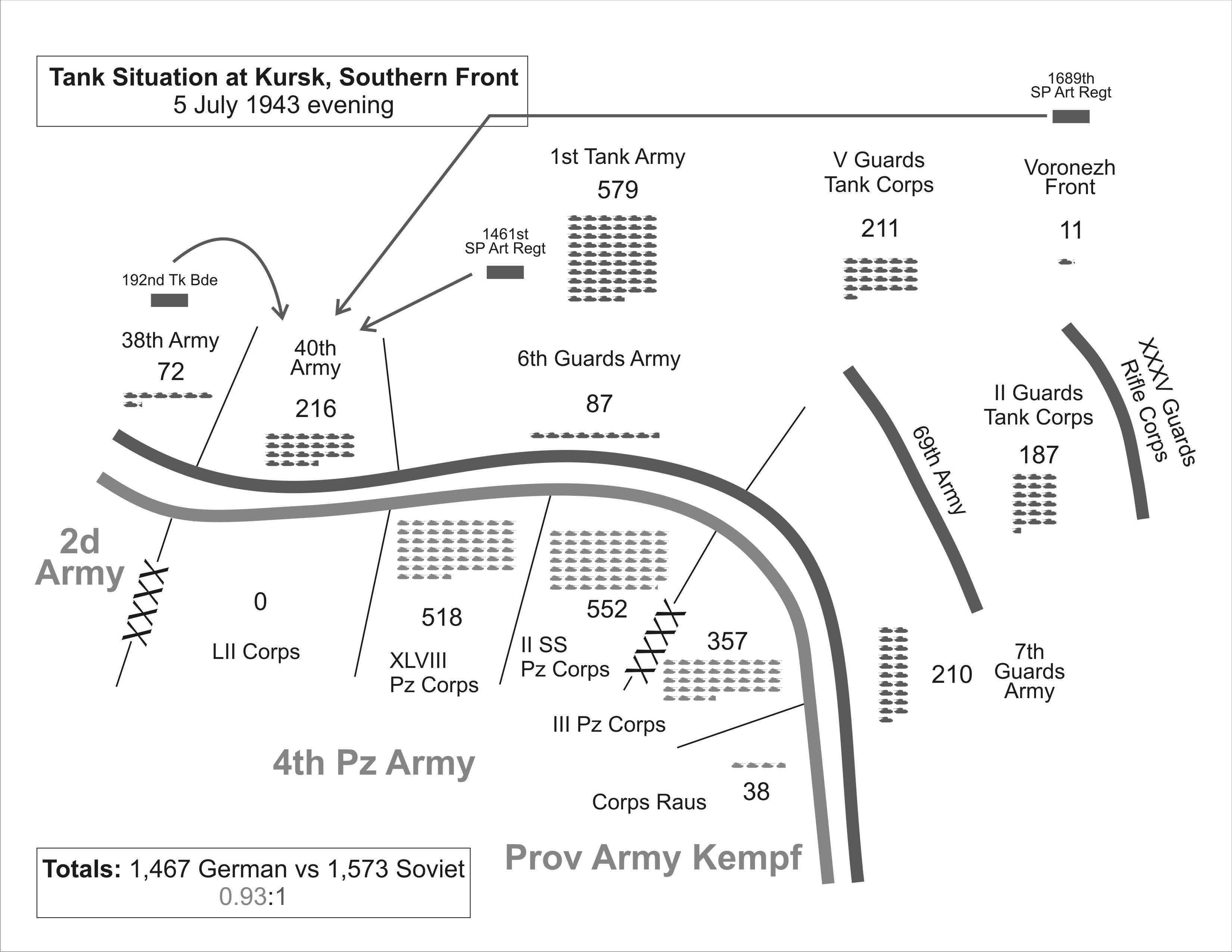
This text is pulled from page 745 of my Kursk book.
By comparison, the XLVIII Panzer Corps from the 5th through the 11th took 449 tank losses, including broken down Panthers, and may have been responsible for 471 Soviet tanks. Even if one assumes 120 Panthers broke down, and subtracts them from the calculation, this comes out to a 1-to-1.43 exchange ratio. One could, rather, look at the losses from the 6th to the 11th of July for both German corps. This has the advantage of skipping the 5th, when both German corps were penetrating the defensive lines and not facing much armor. Furthermore, it also eliminates a lot of the Panther losses and German losses to mines on the 5th. In this case, from 6 to 11 July, the SS Panzer Corps lost 234 tanks and may have been responsible for 598 Soviet tanks. This is a 1-to-2.56 exchange ratio. The XLVIII Panzer Corps lost 317 tanks while they may have been responsible for 438 Soviet tanks. This is a 1-to-1.38 exchange ratio.
This difference in the exchange ratios between the two German corps probably had a lot more to do with how their opponents choose to fight than the differences in performance between the two German corps. One does wonder if Katukov’s decision to defend with his First Tank Army was the main difference here, as compared to the heavy counterattacking against the SS Panzer Corps that was done under the command of Vatutin and Chistyakov.
In retrospect maybe I should have included this discussion in Chapter 3: Attacker versus Defender of my book War by Numbers: Understanding Conventional Combat. There is a lot of the other Kursk material there in my discussion of human factors in combat.

Tank loss ratios are difficult to analyse, since tanks get damaged or destroyed in so many different ways and enemy tanks are but one of them.
In this case, I would guess that most Soviet tank losses are inflicted by German tanks but conceivably, a smaller percentage of German tank losses are caused by Soviet tanks. But unless we have some solid data on this, it is difficult to proceed.
Well, since losses are a function of munitions expenditure, the ammo consumption of the 2nd SS Panzer Corps (report 12.07.1943) by type: 1,387 105mm Gr.19; 170 210mm Mörser 18, 537 50mm Spgr 38 Pak; 720 50mm Pzgr 39 Pak; 913 50mm Spgr KwK 39; 692 50mm Pzgr 39 KwK; 155 75mm Spgr Pak 40; 375 75mm Pzgr 39; 78 75mm GrPatr HL/A/B; 5,460 75 mm Spgr KwK 40; 3,840 75mm Pzgr 39 KwK; 1,135 75mm Grpatr HL/B for a total of 1,645 t consumed. Panzer III (L60) ammo consumption in 10 days (IIIrd PzK, 346 tanks): 2,446 APCBC , 4,098 HE and 254 APCR.
That would be roughly 5-6 shots (all types of AT/AFV rounds) on average to inflict a permanent loss, per day.
also from a Soviet report RGAZ.F.8752.OP.7.D.41.L.11 (central front, Kursk-Orel), T-34s destroyed by type (%): 37mm 10.5, 50mm 23.0, 75mm 40.5, 88mm 26.0, close combat was usually responsible for 5-6% and arty + mines for 8-10% of the losses, since the Soviets were in the defensive these can be excluded here, except for pioneer action. 38,9%-24%-21,45% (Panzers, AT and tank hunters) is the distribution (of incurred by) for the subsequent year.
I assume that it should be similar for the previous year (so more than 600-700 tanks knocked out by AFVs up to the 15th July), due to overlapping I would say that the figure for AT is inevitably too low, but this would indicate that the vast majority of Soviet tanks were knocked out by 7.5cm KwK (more than 300 ~ 25%, at least 70% of those must have been T-34s).
In principle losses are a function of ammunitions expenditure, it is virtually impossible to know what that function looks like for a given battle or operation.
I regard it as more likely that when attacking, the tanks will kill more enemy tanks than other assets of a division. In defence, it may be different. However, I have seen German claims from Panzergruppe West in Normandy, and despite the fact that teh Germans were predominantly defending in Normandy, tanks still dominated. Of course claims should be regarded with suspicion, but I doubt that tankers were far more prone to exaggeration than AT gunners or soldiers manning other direct firing weapons. Indirect artillery is more difficult to judge however.
It has been often asserted, that the 5thGdsTA demise was a result of well prepared AT positions (and a ditch) rather than German tanks.
It may be wise to feed something like Eureqa with data on munitions consumption for each operation and casualty/asset infliction, but the license is just so expensive.
Additionally, what is also of particular interest, is how damage was interpreted. How exactly does damage (by the observed failure modes) by 75mm Kwk fire distinguish itself from Pak fire?
When inspecting a destroyed tank, it is often possible to ascertain which kind of ammunition that caused the destruction, but as you said, what if the same type of shell could be fired from many different guns?
In some cases it could be concluded that the 7,5 cm shot must have been fired with such high velocity that most guns can be excluded, but that would require careful inspection and in many cases even that would not help.